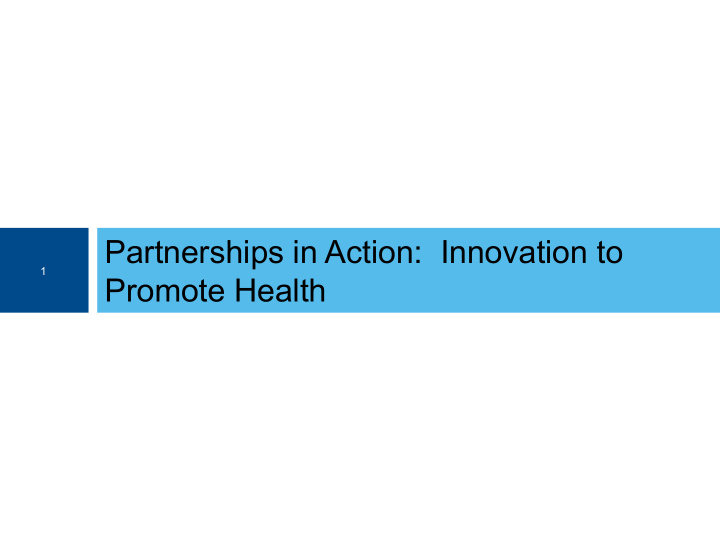



Partnerships in Action: Innovation to 1 Promote Health
We Are Stronger When We Partner! A Case Study on Partnering in One Springfield Neighborhood IPHA 76 th Annual Meeting: September 20, 2017 Patrick Daniels, MS, Bureau of Radiation Safety, Radon Program Illinois Emergency Management Agency; Chris Jones: Springfield Neighborhood Police Officer; Dawn Mobley: Enos Resident (neighborhood association), Community Health Worker,, Parent Educator; Tracey Smith, DNP, PHCNS-BC, MS: Director of Population Health, SIU Family and Community Medicine
Community Health Needs Assessment 3 Data on 100+ community issues Examined & ranked 22 issues 9 priority areas 3-4 final 1
FY17 CHNA Priorities: 4 HSHS Memorial Sangamon County St. John’s Medical Department of Hospital Center Public Health Access to Care Access to Care Access to Care Mental Health Mental Health Child Abuse Obesity Obesity Pediatric Asthma Pediatric Asthma
FY17 CHNA Priorities: 5 Place-based Community Approach Driven Organizational Collective Access Approach Impact to Care
Enos Park Neighborhood 6 Diabetes Hypertension Mental Health Pediatric Asthma
• Narrow, deeper dive • Proof of concept Common Agenda • Collaborate • Measurable Outcomes • Increase number of people with medical home Common Progress • Reduced ED visits for non-emergent health issues Measures • Improve self-sufficiency for program participants • Increase access to children’s mental health services Mutually • Provider Council • Advisory Council Reinforcing • Summer Enrichment Program Activities • Community Health Worker Program • Provider and Advisory Council Communications • Media Relations • Enos Park Neighborhood Improvement Association Backbone • HSHS St. John’s Hospital • Memorial Medical Center Organizations • SIU School of Medicine
Interventions for Increasing Access To Health 8 • Community: – Build a community – Identify Workforce Development / Income Potentials – Pull agencies together • Individuals: – Decrease isolation – Create sense of security / Community – Address social determinants of health • Provide Transportation • Develop new models of housing • Connect and train for income potential
Interventions for Increasing Access To Health 9 • Healthcare System: – Build trust – Utilize harm reduction and trauma informed approaches – CHWs – Focus on the patient narrative – Flexible schedules – Assist patients to decrease no-shows – Primary Care Home – Continuous care model – Coordinate coordinators
Patient Engagement 10 • A Medical Home was created for 100% of our clients. • Engagement with primary care providers (PCP) was high: – 409 PCP appointments made – 96% of our patients saw a PCP at least once in the past year – 83% show rate for PCP • PCP No-show rate decreased to 17% (compared to a 84% rate prior): – Two clients resulted in 35% of those no shows – If they are removed the rate decreases to 11%
Engagement Outcomes 11 Increased: Decreased: • Employment: 50% • Homelessness • Income: 200% • No Shows • Food and Nutrition: 50% • Unnecessary ED Use: 38% • Healthcare Coverage: 50% • Crime • Lifeskills: 40% • Recidivism Rate • Mobility: 100% • Police Calls • Community Involvement: 66.7% • Physical Health: 25% But how was this done?
Development of an outreach model: Community Health Worker Model 12 “A frontline public health worker who is a trusted member of and/or has an unusually close understanding of the community served. This trusting relationship enables the worker to serve as a liaison/link/intermediary between health/social services and the community to facilitate access to services and improve the quality and cultural competence of service delivery. A community health worker also builds individual and community capacity by increasing health knowledge and self-sufficiency through a range of activities such as outreach, community education, informal counseling, social support, and advocacy.” (2015) American Public Health Association
Community Health Worker Model 13 • Focus on coordination of care: – Trust – Patient-centered • Clients referred by churches, service agencies, neighbors, schools, hospitals, self-referred, etc. • Identify and connect resources: – Healthcare - Establish a Medical Home – Social - Decrease isolation – Activities of daily living - Housing First Model – Financial
Unique Partnerships with Agencies: Radon Testing and Mitigation: A Hidden Risk but An Opportunity to Increase Health 14 • Illinois Emergency Management Agency – Increase Environmental Health Assessments • Less utilization of testing in blighted neighborhoods often because of low income or rental properties • So we set out to increase testing in these blighted neighborhoods and provide mitigation services – Connect and Train for Income Potential • Train those accepted in the neighborhood to mitigate (residents may be more open to testing and addressing radon issues identified if someone in the community doing the testing and mitigation) • Provide increased training opportunities for positions that are currently being sought in the trades area
Partnership for Community Safety: 15 • Springfield Neighborhood Police Officers – Housing model developed – Work with half-way houses – Summer Enrichment Club Involvement – Outcomes • Effect of recidivism: 19% vs 56.7% nationally • 89% reduction in police calls
What They Said! 16 • “I'm missing a mom, and having someone to call and double check [on me]...Kind of helps me, you know?” • “I work at a homeless shelter at Inner City Mission. [Shelly] came in and was offering services to our residents...One of things Shelly did was helped our residents find a family doctor.” • “Getting off the medical card is stressful and it's overwhelming. Not that you want to be dependent on the government for your lifespan, but the transition...without that kind of help, I think it's very difficult.”
Questions? 17
Recommend
More recommend